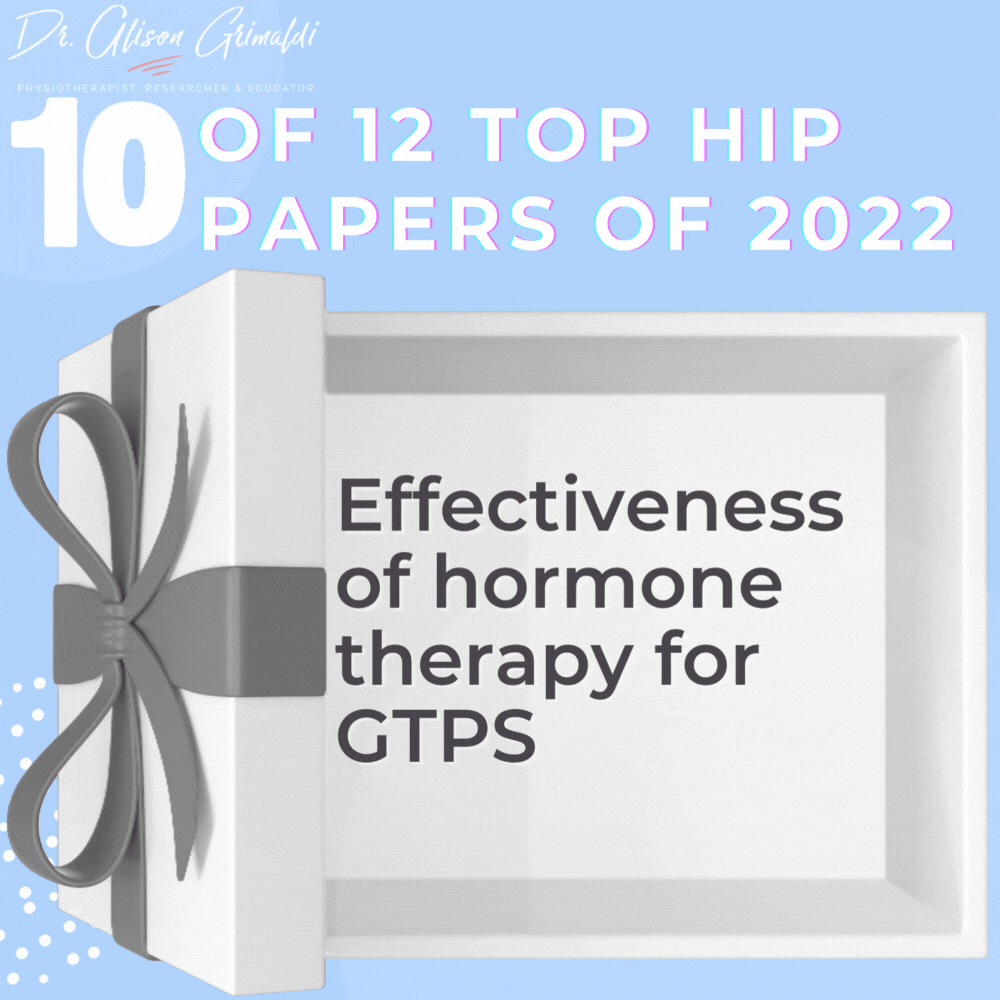11 of 12 Top Hip Papers of 2022 | Nerve related groin pain

Today is day 11 of my 12 Top Hip Papers of 2022 miniblog series. Only 1 more day to go! Don't miss tomorrow - I have saved a special paper for last! If you missed day 10, pop down to the bottom of the blog to move back through the series. On Day 11, I will be sharing some clinical insights from a paper that looked at diagnosis of nerve related groin pain and particularly differentiating femoroacetabular impingement or hip related pain, from nerve related groin pain.
Do you consider nerve related pain in assessment of anterior hip, lower abdominal and groin pain? What tests do you use? Read below about a new test combination these authors suggest.

Have you heard about Hip Academy?
Enjoy the benefits of a world class educational Hip Program, specifically designed by Dr Alison Grimaldi to help improve your knowledge surrounding the Hip and Pelvis, and become an expert in your field.
With all Hip Courses included, enjoy all the extra inclusions, including; access to the entire eBook series, growing video library, expanding PDF resource centre, regular member meetings, forums + lots more!

11 of 12 Top Hip Papers of 2022: Groin pain of neurological origin as a differential diagnosis of FAI
Nerve related groin pain can be challenging to diagnose in clinic, as there are no validated neurodynamic tests specifically for the smaller nerves of the groin (ilioinguinal, iliohypogastric and genitofemoral nerves). Sensory testing may also be normal in peripheral nerve entrapment, as the fibres that carry light touch sensation are large myelinated fibres that are much less affected by compression than the smaller unmyelinated nociceptive fibres.
The clinician then often relies on the patient's report of area and nature of pain, past history and a clinical examination to exclude other causes. This paper shared clinical information gained from a high volume orthopaedic clinic, and their insights on an additional physical test for nerve related groin pain.
Study Aim:
The main aim of this study was to share the clinical experience of the diagnostic process and treatment of patients with nerve related groin pain associated with entrapment of iliohypogastric, ilioinguinal, and genitofemoral nerves in a high volume orthopaedic clinic. A diagnostic algorithm is proposed to differentiate nerve related groin pain from femoroacetabular impingement syndrome (FAIS).
What was done:
A clinical assessment of those at risk of nerve related groin pain was performed, including palpation, hip flexion, FADIR and Palpation + FADIR Test. Area and nature of pain and past history increases suspicion of nerve related groin pain. Diagnosis of nerve related groin pain was confirmed with a local nerve block.

A clinical assessment of those at risk of nerve related groin pain was performed, including palpation, hip flexion, FADIR and Palpation + FADIR Test. Area and nature of pain and past history increases suspicion of nerve related groin pain. Diagnosis of nerve related groin pain was confirmed with a local nerve block.
Assessment of suspected nerve related groin pain
Palpation of Groin Pain Region
- Palpation of area of innervation of the iliohypogastric (IH), ilioinguinal (II)& genitofemoral (GF) nerves (See image below)
- Positive Test: Tenderness on palpation and reproduction of familiar groin pain.
Assessment of Hip Flexion and FADIR Test
- Passive hip flexion and FADIR Test (Flexion-adduction-internal rotation) were performed
- Positive Test: Reproduction of familiar groin pain.
Palpation + FADIR Test
- If painful on FADIR and tender on palpation, maintain pressure on the tender area and add hip FADIR action - hip flexion-adduction-internal rotation.
- Positive Test: If the pain did not change when FADIR was added, nerve related groin pain was considered.
Nerve Block
- Possible cases of nerve related groin pain were sent for ultrasound guided block (injection of local anaesthetic, corticosteroid and saline) of iliohypogastric, ilioinguinal and genitofemoral nerves.
- Positive Test: Groin pain was alleviated by the nerve block.
Other Assessments
- Patient history was collected, including previous surgical intervention in the region.
- Hip radiographs and MRI were used to rule out structural pathologies.
- Inguinal canal and gynaecologic pathologies were ruled out in the differential diagnoses.
- Evoked potentials were used to assess abnormalities in nerve transmissions in uncertain cases.
This paper also describes management of nerve related groin pain including non surgical strategies (injection and medication) and surgical neurectomy for recalcitrant cases.
Key Findings:
This study showed that:
- a positive FADIR test is common in those with nerve related groin pain.
- 50% of this cohort (n=30) had a positive FADIR.
- FADIR test loads structures other than intra-articular structures.
- a high proportion (19/30) of this cohort with nerve related groin pain had undergone previous groin, abdominal or gynaecological surgery.
- Traction or scarring from previous surgery may result in nerve injury or entrapment of iliohypogastric, ilioinguinal or genitofemoral nerves.
My main focus in this miniblog was to share the potential usefulness of the information in the clinical diagnosis of nerve related groin pain. For interventional health professionals or others who are interested, you might like to read the paper for outcomes of the treatments provided to this group - injection, medication and neurectomy.

Clinical Implications:
This paper provides some further information that may assist in the differential diagnosis of groin pain.
- Be aware that false positive tests on FADIR may occur in nerve related groin pain.
- Try pairing FADIR with palpation to differentiate nerve pain.
- The authors suggest that pain on palpation that doesn’t change with FADIR, increases likelihood of nerve related groin pain.
- Be suspicious of nerve related groin pain in those who have had previous groin, abdominal or gynaecological surgery.
- A nerve block is recommended to confirm diagnosis of nerve related groin pain.
While this retrospective study represents low-quality evidence of diagnostic utility of the Palpation + FADIR Test, the findings of a high volume orthopaedic clinic may be of value to clinicians while we await high-quality prospective, blinded studies to be undertaken in this space.
Like to learn more about assessment and treatment of patients with nerve related groin pain or anterior hip pain?
In this course, you can find detailed information on pathoaetiology, assessment and management of nerve related anterior hip and groin pain and many other conditions. Take the online course or join me for a workshop. In both the face-to-face and live online workshops you'll get to practice some great nerve gliding exercises. I've found these to be very useful for many patients with nerve related anterior hip or groin pain.
This online course is included in Hip Academy and Hip Academy members receive discounts for online workshops.
I hope you enjoyed the infographics and key learnings from Day 11 of my 12 Top Hip Papers of 2022. There is ONLY 1 MORE PAPER TO COME, and this is the most awaited paper so far! so stay tuned and return to the blog page tomorrow to see what special paper I have selected for you!
If you missed yesterday's Hip Paper, click the link below to catch up!



